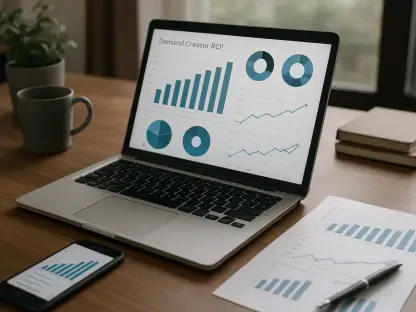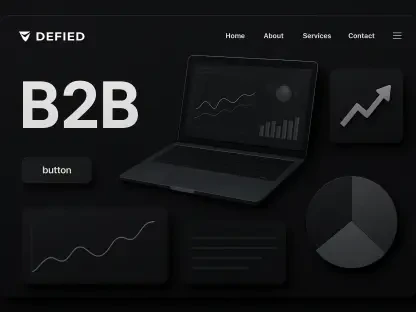In today’s competitive digital landscape, standing out among countless businesses vying for attention is a significant challenge, especially for B2B companies seeking meaningful connections. Imagine a platform where over 79% of B2B marketers, as reported by a recent Statista survey, consider it the most valuable social media tool for reaching professional audiences. LinkedIn offers precisely that opportunity, serving as a powerful hub for networking and brand building. This guide aims to help businesses enhance their online presence by leveraging LinkedIn SEO, a strategy that amplifies visibility both within the platform and on external search engines like Google. By following the actionable steps outlined, companies can position themselves to attract the right audience and drive engagement.
The importance of LinkedIn SEO cannot be overstated in an era where professional credibility and targeted outreach are paramount. Unlike other social media platforms, LinkedIn caters specifically to a professional demographic, making it an ideal space for establishing authority and forging valuable partnerships. This guide explores how optimizing profiles and content can transform a business’s reach, offering a roadmap to navigate the platform’s unique algorithm and search dynamics. Readers will discover practical strategies to ensure their brand not only appears in relevant searches but also resonates with decision-makers and industry peers.
Understanding the potential of LinkedIn SEO means recognizing its capacity to bridge gaps between businesses and their ideal clients or collaborators, especially with millions of users actively seeking solutions and expertise. A well-optimized presence on LinkedIn can serve as a beacon for opportunity. This guide is designed to break down complex concepts into manageable actions, ensuring that even those new to digital marketing can implement effective changes. By delving into the nuances of profile optimization and content strategy, businesses can unlock a powerful tool for growth and visibility.
Unveiling the Power of LinkedIn SEO for Business Growth
LinkedIn has evolved far beyond a mere job search platform, establishing itself as a cornerstone for professional networking and B2B marketing. A compelling statistic from a 2023 Statista survey reveals that 79% of B2B marketers rank LinkedIn as a top social media platform, underscoring its critical role in connecting businesses with targeted audiences. This section introduces the transformative potential of LinkedIn SEO, a method that enhances a company’s discoverability among professionals seeking specific services or expertise. By optimizing profiles and content, businesses can ensure they stand out in a crowded digital space, capturing attention where it matters most.
The impact of LinkedIn SEO extends beyond the platform’s boundaries, influencing visibility on major search engines like Google. When a company’s LinkedIn presence is fine-tuned with strategic keywords and engaging content, it can appear in broader online searches, drawing in potential clients or partners who might not have initially navigated to LinkedIn. This dual benefit of internal and external reach makes LinkedIn SEO an indispensable tool for modern businesses aiming to expand their digital footprint. The following sections promise a detailed roadmap, offering actionable insights to maximize exposure and engagement.
For those looking to stay ahead in a competitive market, LinkedIn SEO presents an opportunity to build a robust online identity that resonates with industry stakeholders. The platform’s unique focus on professional interactions means that optimization efforts can yield highly targeted results, connecting businesses directly with decision-makers. By exploring the strategies to come, companies can harness LinkedIn’s potential to not only increase visibility but also foster meaningful relationships that drive long-term growth and success.
Why LinkedIn SEO Matters in the Digital Landscape
In the ever-shifting realm of digital marketing, LinkedIn stands out as a vital arena for establishing brand authority and engaging with professional communities. No longer just a space for job seekers, the platform has become a dynamic environment where businesses can showcase expertise and build trust among niche audiences. LinkedIn SEO plays a pivotal role in this transformation, ensuring that a company’s content and profile are easily discoverable by those who matter most, thereby enhancing its relevance in a professional context.
The significance of LinkedIn SEO lies in its ability to improve visibility through the platform’s algorithm-driven search results while also contributing to off-platform discoverability. Content optimized for LinkedIn often gets indexed by external search engines, meaning a well-crafted profile or article can attract attention from a wider online audience. This dual advantage allows businesses to reach potential clients or collaborators who may not be active on LinkedIn but are searching for related solutions through other channels, amplifying their overall impact.
Staying competitive in the current digital ecosystem requires businesses to prioritize LinkedIn SEO as a core component of their marketing strategy. With the platform’s unparalleled ability to target B2B audiences, optimization efforts can lead to higher engagement rates and more meaningful interactions. As digital trends continue to evolve, leveraging LinkedIn SEO ensures that companies remain visible and relevant, positioning them to capitalize on opportunities for partnerships, lead generation, and thought leadership within their industries.
Mastering LinkedIn SEO: Key Strategies for Visibility
Optimizing a business presence on LinkedIn requires a strategic approach that aligns with the platform’s best practices and user expectations. LinkedIn SEO is not merely about visibility but about creating a profile and content strategy that resonates with the right audience. This section provides a comprehensive guide to mastering LinkedIn SEO, breaking down essential tactics that can significantly enhance a company’s reach and influence on the platform.
The strategies outlined here are grounded in proven methods and expert insights, ensuring that businesses can implement changes with confidence and achieve meaningful results. From profile completion to content creation, each element plays a crucial role in signaling quality to LinkedIn’s algorithm and attracting user attention. By following these steps, companies can build a robust presence that drives engagement and positions them as leaders in their field.
Beyond immediate visibility, LinkedIn SEO fosters long-term credibility and connections that can translate into tangible business outcomes. The actionable steps detailed below cover every aspect of optimization, from visual branding to content discoverability, ensuring a holistic approach. Businesses ready to invest time and effort into these strategies will find themselves better equipped to navigate LinkedIn’s competitive landscape and achieve sustained growth.
Step 1: Build a Comprehensive Profile for Maximum Impact
A fully completed LinkedIn profile serves as the foundation for effective SEO on the platform, directly influencing how often a business appears in search results. According to LinkedIn’s own data, profiles that include all key details receive 30% more views than incomplete ones, highlighting the importance of thoroughness. This subsection guides businesses through the process of creating a profile that not only attracts attention but also signals quality to the platform’s algorithm for better rankings.
Attention to detail in profile setup can make a significant difference in how a business is perceived by potential clients and partners. Filling out every section with accurate, relevant information ensures that LinkedIn categorizes the company correctly, improving its chances of appearing in targeted searches. The following components are critical to crafting a profile that maximizes impact and visibility across professional networks.
Each element of a LinkedIn profile contributes to a cohesive brand image that can leave a lasting impression on viewers, and by prioritizing completeness and consistency, businesses can avoid being overlooked in favor of competitors with more polished profiles. The specific areas to focus on, detailed below, provide a clear path to achieving a standout presence on the platform.
Craft a Professional Visual Identity
Visual elements are often the first point of interaction for users browsing LinkedIn, making a professional appearance non-negotiable. A high-quality company logo, sized according to LinkedIn’s specifications of 300×300 pixels, instantly boosts brand recognition and conveys credibility. Additionally, a well-designed banner image can visually communicate a company’s ethos, enhancing the overall impression left on visitors.
Consistency in visual branding across LinkedIn profiles reinforces a business’s identity, making it easily recognizable in search results and feeds. Ensuring that images are clear and professionally crafted prevents any negative first impressions that could deter potential connections. Regular checks on how these visuals display across devices further guarantee a polished look that invites engagement.
Beyond aesthetics, visuals on LinkedIn serve a functional purpose by aligning with the platform’s algorithm preferences for complete profiles. High-resolution images that adhere to recommended dimensions contribute to a sense of professionalism, encouraging users to explore further. Investing in quality visuals is a simple yet effective step toward building a compelling online presence.
Define Your Business with a Clear Overview
A concise and impactful business overview is essential for communicating what a company stands for and what it offers. This section, often the first detailed text users read, should articulate the unique value proposition in a way that captures interest and leaves a lasting impression. A well-written summary not only informs but also improves relevance in search results by aligning with user intent.
Clarity in the overview helps LinkedIn’s algorithm understand the business’s focus, ensuring it appears in searches by the right audience. Including key details about services, mission, or industry differentiators can set a company apart from competitors with generic descriptions. This targeted approach increases the likelihood of attracting meaningful connections and inquiries.
Crafting this section requires a balance of brevity and informativeness, ensuring that essential points are conveyed without overwhelming readers. By focusing on what makes the business unique, the overview becomes a powerful tool for engagement. Regular updates to reflect new achievements or offerings keep this section relevant and aligned with current goals.
Add Essential Organizational Details
Specifying critical organizational details such as industry, company size, and location is vital for accurate categorization within LinkedIn’s search framework. These elements help the platform match the business with users searching for specific types of companies or services in particular regions. Accurate data ensures that visibility is directed toward the most relevant audience segments.
Including these details also enhances trust, as users often seek out businesses with transparent and complete profiles. A fully filled-out profile signals reliability and professionalism, increasing the chances of being contacted by potential clients or collaborators. Neglecting this step can result in missed opportunities to connect with those actively seeking similar offerings.
Regularly updating organizational information to reflect changes in size, location, or focus keeps the profile aligned with current business realities. This practice not only aids LinkedIn’s algorithm in delivering accurate search results but also maintains credibility among viewers. Attention to these seemingly small details can yield significant improvements in targeted reach.
Step 2: Leverage Keywords to Enhance Discoverability
Keywords are the backbone of LinkedIn SEO, guiding the platform’s algorithm to understand and rank content based on user search intent. Strategically placing relevant terms in high-visibility areas like headlines, taglines, and descriptions ensures that a business appears in searches by the right audience. This subsection explores how to identify and use keywords effectively to boost discoverability.
While keywords are essential, overloading content with them, often referred to as keyword stuffing, can harm visibility and professionalism. The focus should remain on relevance and natural integration, ensuring that the profile reads authentically while still appealing to search algorithms. Striking this balance is key to maintaining user trust and algorithmic favor.
Implementing a keyword strategy requires ongoing refinement to adapt to changing search behaviors and industry trends. By prioritizing terms that reflect actual user queries, businesses can position themselves as solutions to specific needs. The tips provided below offer practical ways to uncover and apply keywords for maximum impact on LinkedIn.
Identify Relevant Terms with LinkedIn Search Suggest
Finding the right keywords starts with understanding what users are actually searching for on LinkedIn, and the platform’s Search Suggest feature is an invaluable tool for this purpose. By typing a basic term related to a business into the search bar, dropdown suggestions reveal real user queries, providing insight into valuable phrases. This method ensures that selected keywords align with genuine search behavior.
Using LinkedIn Search Suggest helps businesses avoid guesswork, focusing instead on terms that are already driving traffic within the platform. This data-driven approach increases the likelihood of appearing in relevant searches, connecting with users who are actively seeking specific expertise or services. It’s a straightforward way to refine content for better alignment with audience needs.
Regularly revisiting this tool to capture evolving search trends keeps a business’s keyword strategy current and effective, ensuring it adapts to the dynamic online landscape. As user interests shift, updating profiles and posts with newly popular terms maintains relevance in search results. This proactive stance ensures sustained visibility in an ever-changing digital environment.
Place Keywords Naturally for Authenticity
Once relevant keywords are identified, integrating them naturally into content is crucial to maintaining a professional tone on LinkedIn. Forcing terms into headlines or descriptions where they don’t fit can make a profile appear contrived, potentially alienating users and triggering algorithmic penalties. Authenticity in language fosters trust and engagement among viewers.
Strategic placement of keywords in areas like the business overview or post captions ensures they contribute to searchability without compromising readability. The goal is to weave these terms into content seamlessly, so they enhance rather than detract from the overall message. This balance is essential for appealing to both users and LinkedIn’s ranking system.
Monitoring the impact of keyword usage through engagement metrics can guide adjustments over time, ensuring optimal performance. If certain terms fail to resonate with the audience, replacing them with alternatives based on fresh research keeps the profile dynamic. This iterative process supports long-term visibility while preserving a genuine brand voice.
Step 3: Boost Engagement with High-Quality Visuals and Content
Engagement is a critical factor in LinkedIn’s algorithm, with high-quality visuals and content serving as catalysts for user interaction. Professional imagery and thoughtfully crafted posts not only attract attention but also signal value to the platform, improving search authority over time. This section highlights how to leverage these elements for maximum impact.
Visuals and content work hand in hand to create a compelling LinkedIn presence that encourages likes, comments, and shares. By prioritizing quality in both areas, businesses can build a profile that stands out in feeds and search results, fostering deeper connections with their audience. The following tips provide actionable ways to enhance engagement through strategic design and messaging.
Consistency in posting and maintaining high standards for visual and written content can transform a LinkedIn profile into a hub of activity. Engagement metrics serve as feedback, indicating what resonates with viewers and guiding future efforts. By focusing on clarity and relevance, businesses can create a cycle of interaction that continually boosts their visibility.
Optimize Images for Clarity Across Devices
High-quality images are non-negotiable for making a strong impression on LinkedIn, where visuals often determine whether users pause to explore a profile or post. Ensuring that profile photos, logos, and content images are clear and adhere to LinkedIn’s specifications, such as 300×300 pixels for logos, is essential. Previewing these visuals on both mobile and desktop devices guarantees they remain impactful regardless of how they’re viewed.
Poorly rendered or blurry images can create a negative first impression, reducing the likelihood of clicks or engagement. Taking the time to upload high-resolution files that meet platform guidelines prevents such pitfalls, enhancing the overall professionalism of a business’s presence. This attention to detail can significantly influence user perception and interaction rates.
Regularly updating visuals to reflect current branding or campaigns keeps the profile fresh and relevant, encouraging repeat visits from followers. Testing different image styles or compositions based on engagement data can also refine the approach over time. Optimized visuals are a simple yet powerful way to elevate a LinkedIn profile’s appeal and effectiveness.
Create Resonant Posts for Audience Connection
Content on LinkedIn must be tailored to resonate with specific audiences, driving engagement through relevance and value. Posts that address niche topics or use targeted keywords, such as “social media marketing for beauty brands,” can attract the right viewers and spark meaningful interactions. This focused approach ensures that content aligns with the interests of a business’s ideal demographic.
Crafting posts that invite discussion, such as sharing industry insights or asking thought-provoking questions, can significantly boost engagement metrics. These interactions signal to LinkedIn’s algorithm that the content is valuable, thereby improving its visibility in feeds and search results. A consistent posting schedule reinforces this effect, keeping the profile active and prominent.
Analyzing which types of posts generate the most response allows for continuous improvement in content strategy, ensuring a sustained connection with the audience. Experimenting with formats like short updates, infographics, or client success stories can uncover new ways to captivate followers. Relevant, engaging content remains a cornerstone of LinkedIn SEO success.
Step 4: Harness LinkedIn Articles for Broader Reach
Publishing long-form articles on LinkedIn offers a unique opportunity to expand a business’s reach beyond the platform’s user base. Unlike standard posts, these articles are indexed by Google, increasing the chances of appearing in external search results and attracting a wider audience. This subsection explores how to leverage LinkedIn articles for enhanced discoverability and authority.
Articles provide a platform to delve into detailed topics, showcasing expertise and offering value that short posts cannot match. By optimizing these pieces for search engines, businesses can tap into off-platform traffic, drawing in readers who may not otherwise encounter their LinkedIn presence. The strategies below outline how to maximize the impact of this powerful tool.
Consistency in publishing articles on relevant subjects can position a business as a thought leader, fostering trust and credibility over time. Monitoring performance metrics, such as views and shares, helps refine topics and styles for future content. LinkedIn articles, when used effectively, become a gateway to broader visibility and influence.
Add Custom SEO Titles and Meta Descriptions
LinkedIn’s built-in SEO tools within the article editor allow businesses to craft custom titles and meta descriptions that enhance off-platform discoverability. These elements help Google better understand and rank the content, increasing the likelihood of appearing in relevant external searches. A well-optimized title can make the difference between being overlooked and attracting significant traffic.
Crafting compelling titles that include primary keywords while remaining concise ensures they capture attention in search results. Meta descriptions, though brief, should summarize the article’s value, enticing users to click through for more information. This targeted optimization bridges the gap between LinkedIn and broader online audiences.
Regularly reviewing the performance of these SEO elements through analytics can guide adjustments, ensuring they remain aligned with search trends. Experimenting with different phrasing or keyword placements can uncover what drives the most clicks. Custom SEO settings are a critical step in extending the reach of LinkedIn articles beyond the platform’s walls.
Cover Industry Topics for Authority
Writing articles on industry trends, case studies, or how-to guides positions a business as an authoritative voice within its field. Content that addresses current challenges or offers actionable solutions naturally attracts readers seeking expertise, enhancing both engagement and search visibility. This approach builds a reputation for thought leadership that can influence long-term brand perception.
Focusing on topics relevant to a specific audience ensures that articles resonate deeply, encouraging shares and discussions that amplify reach. Incorporating data, real-world examples, or unique insights adds depth, making the content stand out in a sea of generic posts. Such articles become valuable resources that users return to and reference.
Selecting subjects that align with both business goals and audience needs creates a strategic content pipeline for sustained impact. Periodic updates to cover emerging trends or revisit evergreen topics keep the profile dynamic and relevant. Establishing authority through LinkedIn articles is a powerful way to drive traffic and credibility simultaneously.
Step 5: Strengthen Credibility with Custom URLs and Verification
Building trust on LinkedIn is essential for attracting clicks and fostering engagement, and customizing URLs while verifying accounts plays a significant role in this process. A tailored URL and a verification badge signal professionalism and authenticity, enhancing search rankings and user confidence. This section details how to implement these elements for improved credibility.
A custom URL makes a profile easier to find in direct searches, while verification distinguishes a business from potential imitators. Both steps contribute to a polished online presence that invites interaction and builds authority over time. The following guidance ensures businesses can navigate these processes with ease and effectiveness.
Maintaining consistency in branding through URLs and ensuring verification status remains active are ongoing tasks that support long-term trust. These elements, though seemingly minor, can significantly influence how a business is perceived in a competitive digital space. Prioritizing credibility through these methods is a vital component of LinkedIn SEO.
Design a Brand-Reflective URL
Customizing a LinkedIn URL to reflect a business’s name or brand identity simplifies direct searches and reinforces recognition among users. This can be achieved through LinkedIn settings by navigating to the public profile section and editing the URL field with a unique, relevant text string. A brand-reflective URL ensures users can easily locate the profile when searching specifically for the company.
Such customization not only aids discoverability but also enhances the professional appearance of shared links, whether in emails or on other platforms. A concise, recognizable URL avoids the clutter of random characters, making it memorable and accessible. This small adjustment can lead to increased traffic.









